Picture a lush, tropical oasis nestled right in your living room, where vibrant greenery thrives in the humid air. You’ll find that many stunning houseplants actually prefer moisture-rich environments, making them perfect candidates for bathrooms, kitchens, or spaces with humidifiers. While some plants struggle in dry indoor conditions, these humidity-loving varieties will flourish and transform your home into a verdant sanctuary. Let’s explore which plants deserve a spot in your indoor jungle.
Contents
- 1 1. Boston Fern
- 2 2. Lush Chinese Evergreen
- 3 3. Glossy Prayer Plant
- 4 4. Trailing Swiss Cheese Plant
- 5 5. Tropical Elephant’s Ear
- 6 6. Delicate Maidenhair Fern
- 7 7. Bold Heart-Leaf Philodendron
- 8 8. Vibrant Peace Lily
- 9 9. Towering Bird’s Nest Fern
- 10 10. Striking Spider Plant
- 11 11. Dainty Purple Waffle Plant
- 12 12. Cascading English Ivy
- 13 13. Rex Begonia
- 14 14. Sturdy Rubber Fig Plant
- 15 15. Showy Dragon Plant
1. Boston Fern
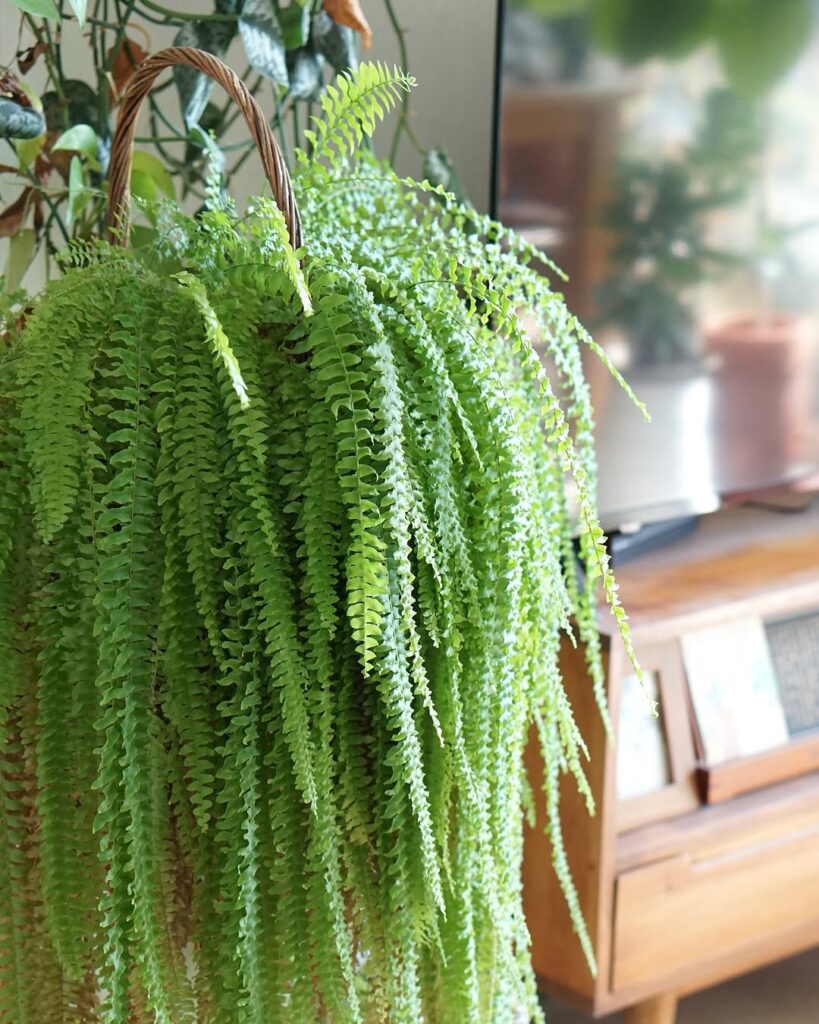
Boston Ferns (Nephrolepis exaltata) are classic hanging plants known for their graceful, arching fronds with small, delicate leaflets that create a fountain-like appearance. These lush, feathery ferns can grow up to 3 feet wide and long, making them excellent choices for hanging baskets or pedestals. Native to tropical regions, they’re one of the most popular indoor ferns due to their attractive appearance and ability to purify indoor air.
- Light: Bright, indirect light; avoid direct sunlight which can scorch leaves
- Humidity: 50% or higher; regular misting or use of humidity tray recommended
- Water: Keep soil consistently moist but not waterlogged; water when top inch of soil feels dry
- Temperature: 60-75°F (16-24°C)
- Soil: Rich, well-draining potting mix with high organic matter
- Feeding: Monthly fertilization during growing season with balanced fertilizer
- Container: Use pot with drainage holes; plastic or glazed ceramic helps retain moisture
2. Lush Chinese Evergreen
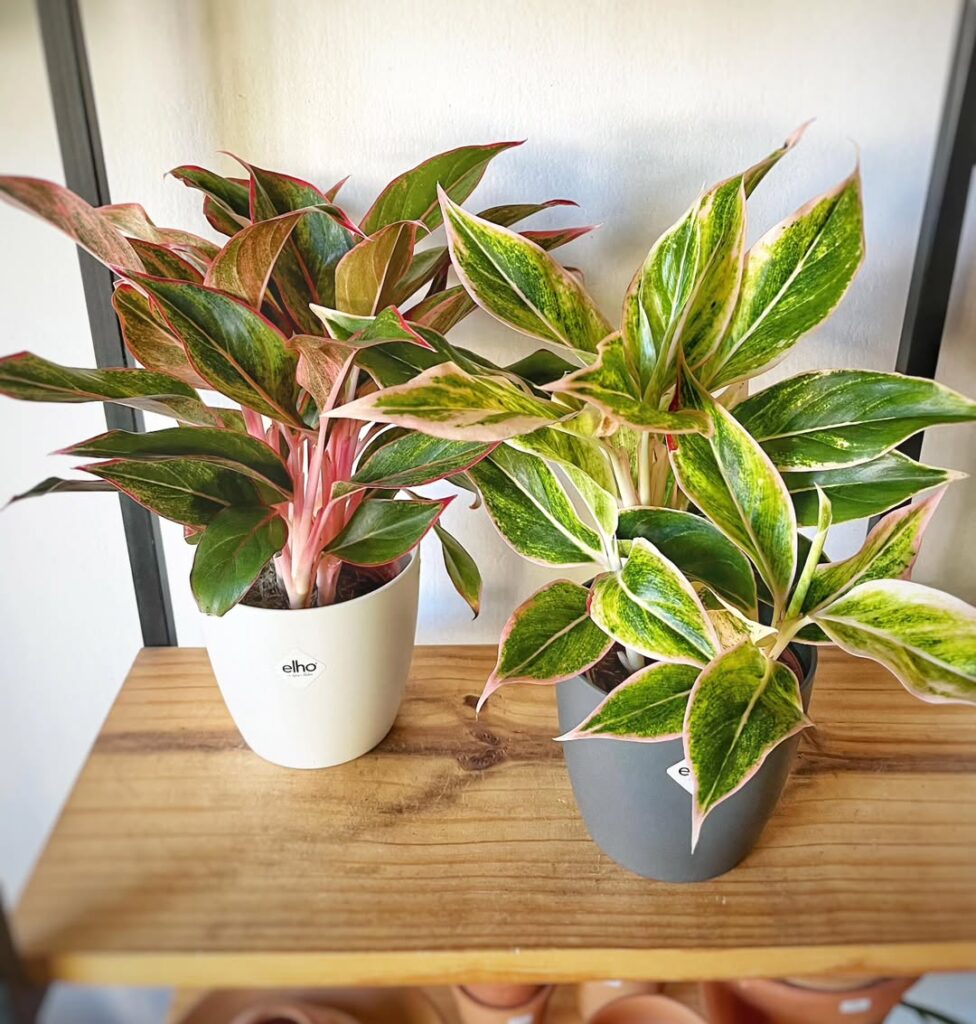
Chinese Evergreen (Aglaonema) is a popular tropical houseplant prized for its lush, variegated foliage that comes in various patterns of green, silver, and cream. This hardy plant features large, oval-shaped leaves that grow from a central stem, creating a full, bushy appearance. Native to tropical Asian forests, Chinese Evergreen thrives in humid environments and is known for its excellent air-purifying qualities and adaptability to indoor conditions.
- Light: Tolerates low to moderate indirect light; avoid direct sunlight which can scorch leaves
- Water: Keep soil consistently moist but not waterlogged; water when top inch of soil feels dry
- Humidity: Prefers high humidity levels above 60%; mist regularly or use a humidity tray
- Temperature: Maintains best growth between 65-80°F (18-27°C)
- Soil: Well-draining potting mix rich in organic matter
- Fertilizer: Feed monthly with balanced liquid fertilizer during growing season
- Container: Use pot with drainage holes to prevent root rot
- Pruning: Remove yellowed or damaged leaves at base to maintain appearance
3. Glossy Prayer Plant
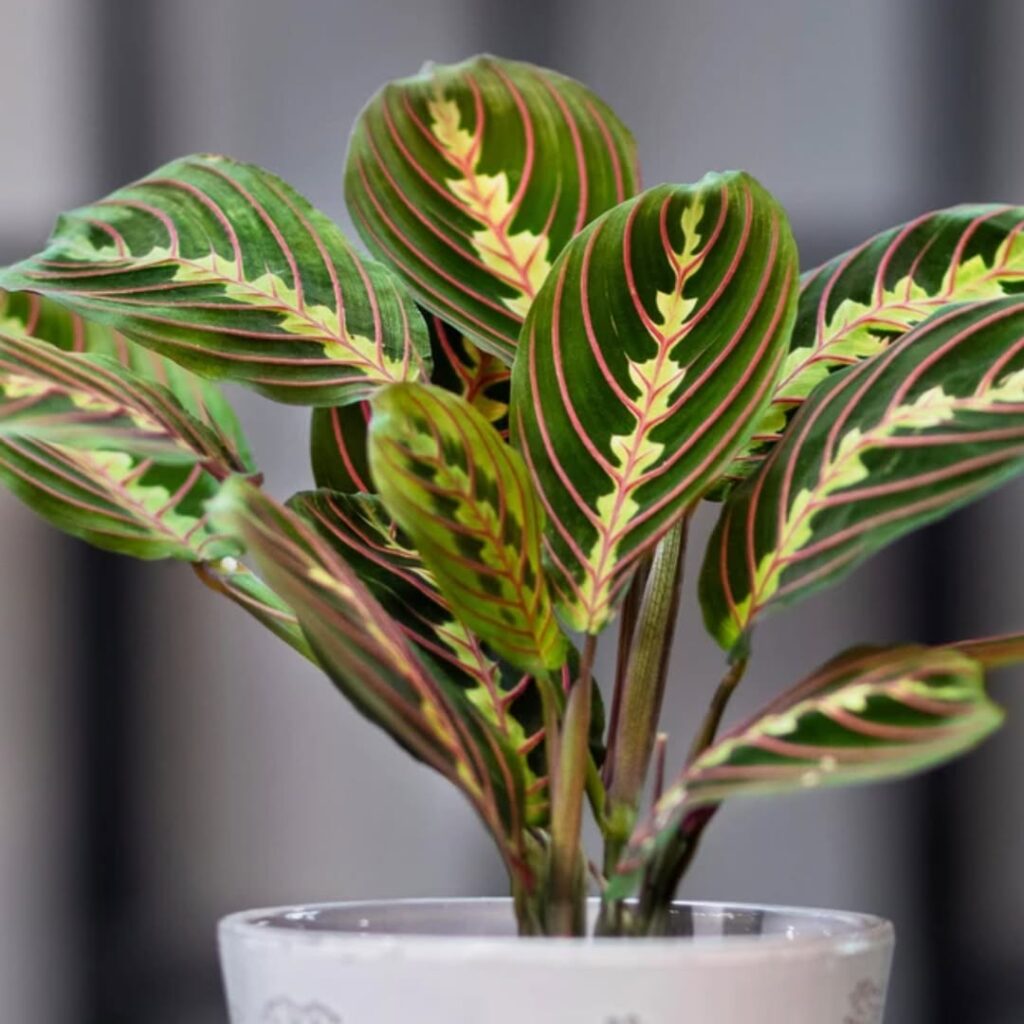
The Glossy Prayer Plant (Maranta leuconeura) is a striking tropical plant known for its distinctive oval-shaped leaves marked with intricate patterns of dark green and light green patches. Its most fascinating feature is the daily movement of its leaves – they raise upward at night like praying hands and lower during the day to catch light. This plant gets its glossy appearance from the smooth, almost polished look of its foliage, which can display various color combinations including red veins and purple undersides.
- Light: Bright indirect light; avoid direct sunlight which can fade leaf patterns
- Water: Keep soil consistently moist but not waterlogged; water when top inch of soil feels dry
- Humidity: High humidity (60% or higher); benefits from regular misting or humidifier
- Soil: Well-draining, rich potting mix with added peat moss
- Temperature: 65-80°F (18-27°C)
- Fertilizer: Feed monthly during growing season with balanced liquid fertilizer
- Pot Type: Container with drainage holes to prevent root rot
- Propagation: Division of rhizomes or stem cuttings in water
4. Trailing Swiss Cheese Plant
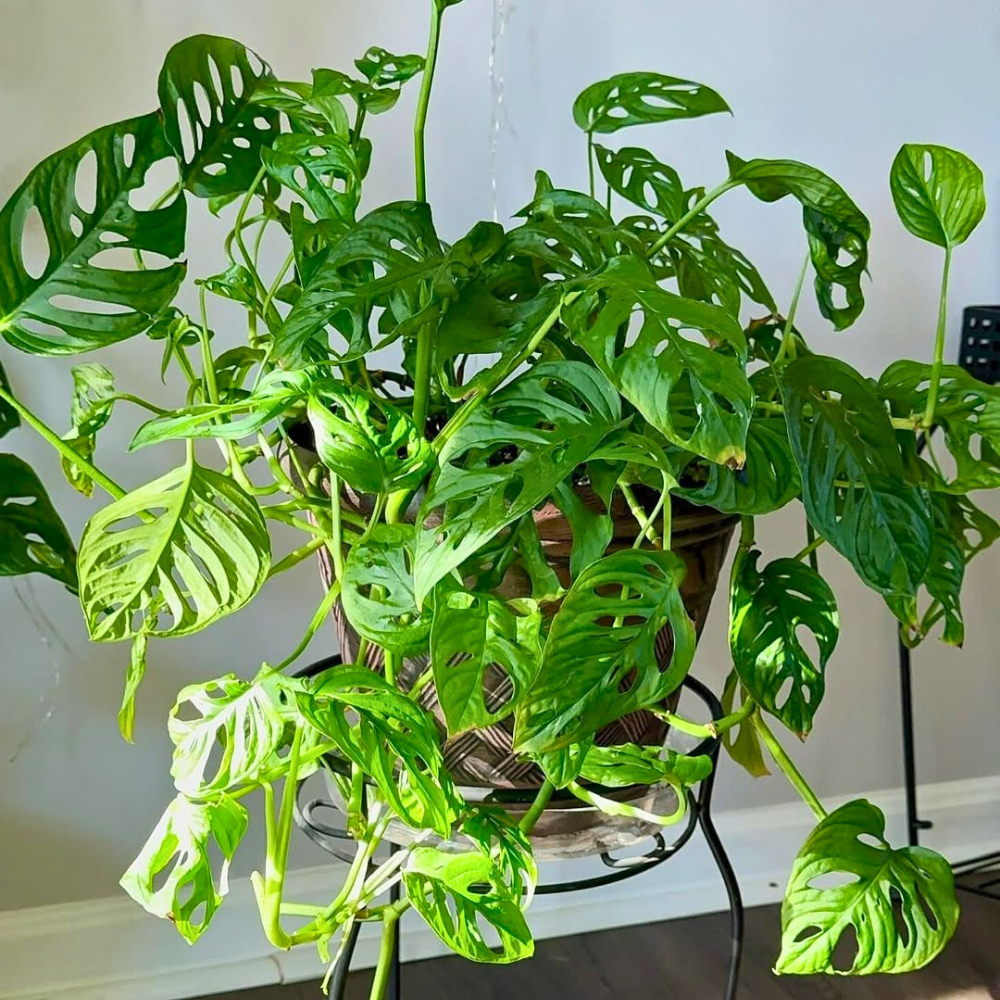
The Trailing Swiss Cheese Plant (Monstera adansonii) is a tropical vine known for its distinctive heart-shaped leaves with natural holes or fenestrations. This charming climber can grow several feet long when properly supported, making it perfect for hanging baskets or training up moss poles. Its smaller size compared to its cousin Monstera deliciosa makes it an excellent choice for indoor spaces, while still providing that dramatic jungle-like appearance that makes Monsteras so popular.
- Light: Bright, indirect light; can tolerate moderate light but avoid direct sun
- Water: Keep soil consistently moist but not waterlogged; water when top 1-2 inches of soil feels dry
- Humidity: 60% or higher; thrives in humid environments
- Temperature: 65-80°F (18-27°C)
- Soil: Well-draining, rich potting mix with added orchid bark and perlite
- Fertilizer: Monthly feeding during growing season with balanced liquid fertilizer
- Support: Provide moss pole or trellis for climbing
- Container: Pot with drainage holes to prevent root rot
5. Tropical Elephant’s Ear
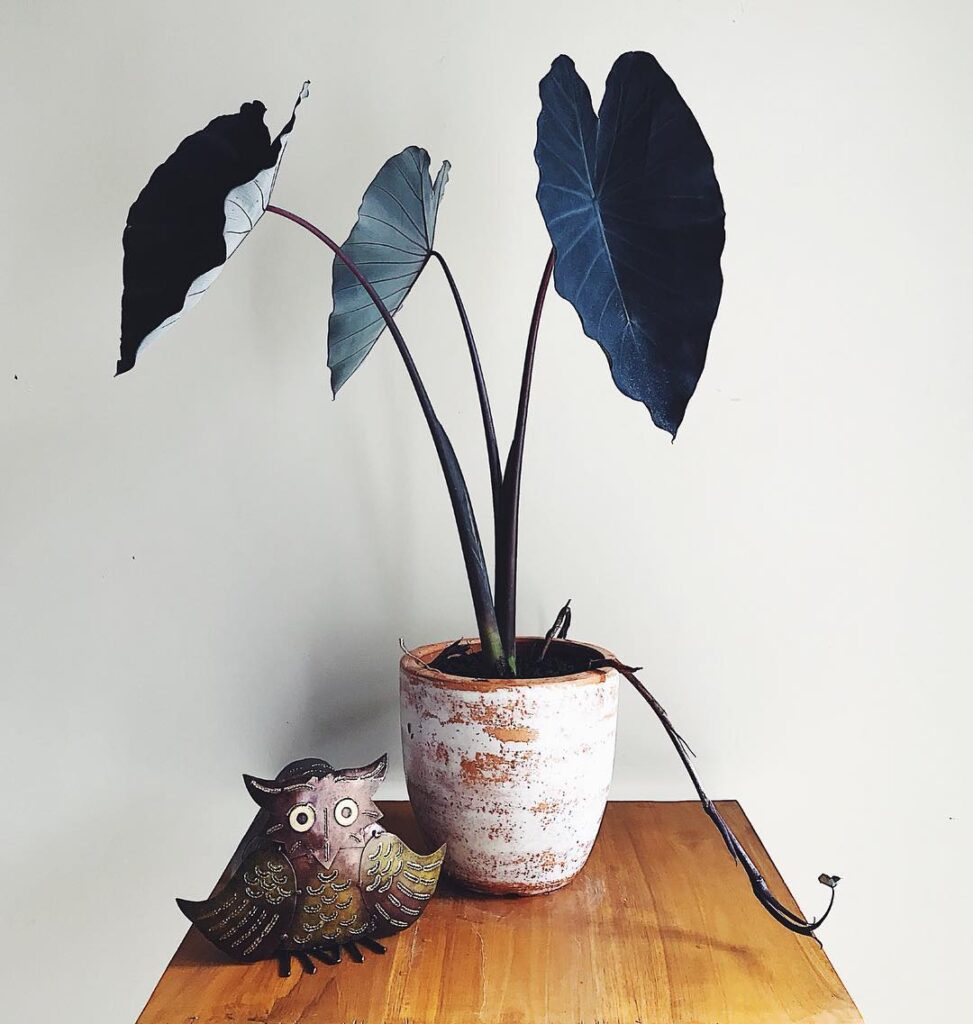
The Tropical Elephant’s Ear (Colocasia esculenta) is a stunning foliage plant known for its large, heart-shaped leaves that can grow up to 3 feet long. This tropical beauty gets its common name from its oversized leaves that resemble elephant ears, adding a bold, dramatic statement to any indoor space. Native to Southeast Asia, this plant thrives in humid environments and can grow quite tall, reaching heights of 3-6 feet when grown indoors.
- Light: Bright, indirect light; can tolerate some direct morning sun but avoid harsh afternoon sunlight
- Water: Keep soil consistently moist but not waterlogged; water when top inch of soil feels dry
- Humidity: High humidity (60-80%); mist regularly or use a humidity tray
- Temperature: 65-85°F (18-29°C)
- Soil: Rich, well-draining potting mix with high organic content
- Fertilizer: Feed monthly during growing season with balanced liquid fertilizer
- Container: Large pot with drainage holes to accommodate extensive root system
- pH: 5.5-7.0
6. Delicate Maidenhair Fern
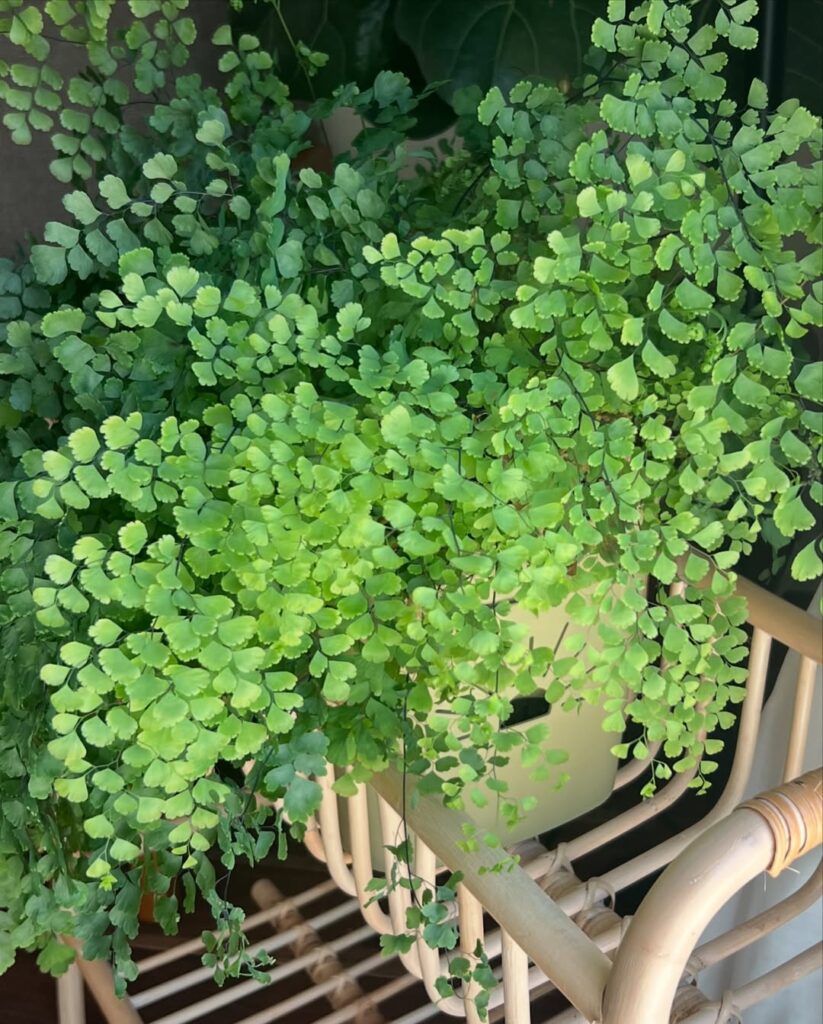
The Delicate Maidenhair Fern (Adiantum), with its lacy, fan-shaped fronds and delicate black stems, is one of the most graceful indoor plants available. Its fine, feathery foliage creates an airy, elegant appearance that adds a touch of sophistication to any space. While beautiful, this fern is known to be somewhat finicky and requires consistent care to maintain its ethereal appearance. The plant’s fronds can grow up to 20 inches long, forming a symmetrical, arching shape that makes it particularly striking in hanging baskets or as a tabletop accent.
- Light: Bright, indirect light; avoid direct sunlight which can scorch leaves
- Humidity: Requires high humidity (60-80%); benefits from daily misting or use of a humidity tray
- Water: Keep soil consistently moist but not waterlogged; water when top inch of soil feels dry
- Soil: Well-draining, rich potting mix with high organic matter content
- Temperature: Prefers 65-75°F (18-24°C); protect from cold drafts
- Fertilizer: Feed monthly during growing season with balanced, water-soluble fertilizer
- Container: Use pots with drainage holes to prevent root rot
- Pruning: Remove dead or yellowing fronds at the base to maintain appearance
7. Bold Heart-Leaf Philodendron

The Bold Heart-Leaf Philodendron (Philodendron hederaceum) is a classic tropical vine known for its glossy, heart-shaped leaves and vigorous climbing nature. Native to Central and South America, this low-maintenance plant features dark green foliage that cascades beautifully from hanging baskets or climbs up moss poles and trellises. Its adaptable nature and air-purifying qualities make it a popular choice for indoor spaces, while its fast-growing habit allows it to quickly fill out spaces with lush greenery.
- Light: Thrives in medium to bright indirect light; avoid direct sunlight which can burn leaves
- Water: Keep soil consistently moist but not waterlogged; water when top 1-2 inches of soil feels dry
- Humidity: Enjoys high humidity levels of 60% or higher
- Temperature: Prefers warm conditions between 65-80°F (18-27°C)
- Soil: Well-draining, rich potting mix with organic matter
- Fertilizer: Feed monthly during growing season with balanced liquid fertilizer
- Support: Provide moss pole or trellis for climbing growth habit
8. Vibrant Peace Lily
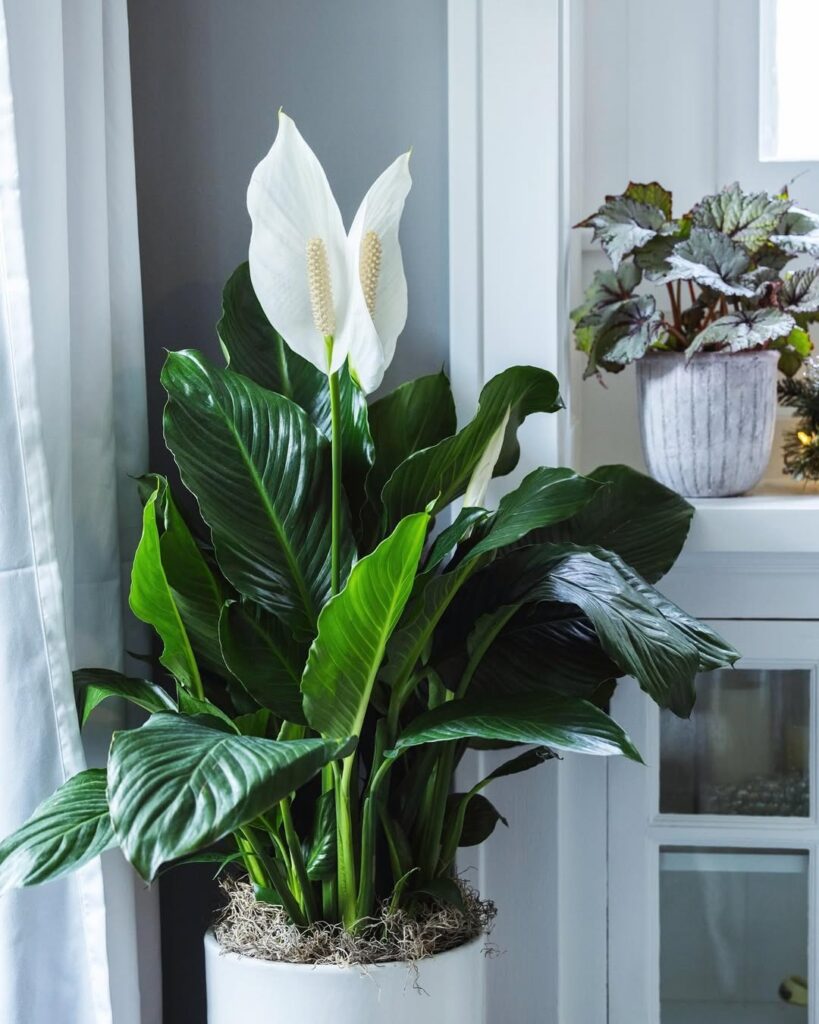
The Peace Lily (Spathiphyllum) is a striking tropical plant known for its glossy dark green leaves and distinctive white flower spathes that rise elegantly above the foliage. This versatile houseplant not only thrives in humid environments but also acts as a natural air purifier, removing common indoor pollutants. While the flowers are eye-catching, the plant’s lush foliage remains attractive year-round, making it a popular choice for indoor spaces.
- Light: Bright indirect light; tolerates low light conditions but may not flower as readily; avoid direct sunlight
- Water: Keep soil consistently moist but not waterlogged; water when top inch of soil feels dry
- Humidity: Prefers high humidity (50-60%); benefits from regular misting or humidifier
- Soil: Well-draining potting mix rich in organic matter
- Temperature: 65-80°F (18-27°C); protect from cold drafts
- Fertilizer: Feed monthly with balanced liquid fertilizer during growing season
- Container: Plant in pot with drainage holes to prevent root rot
9. Towering Bird’s Nest Fern
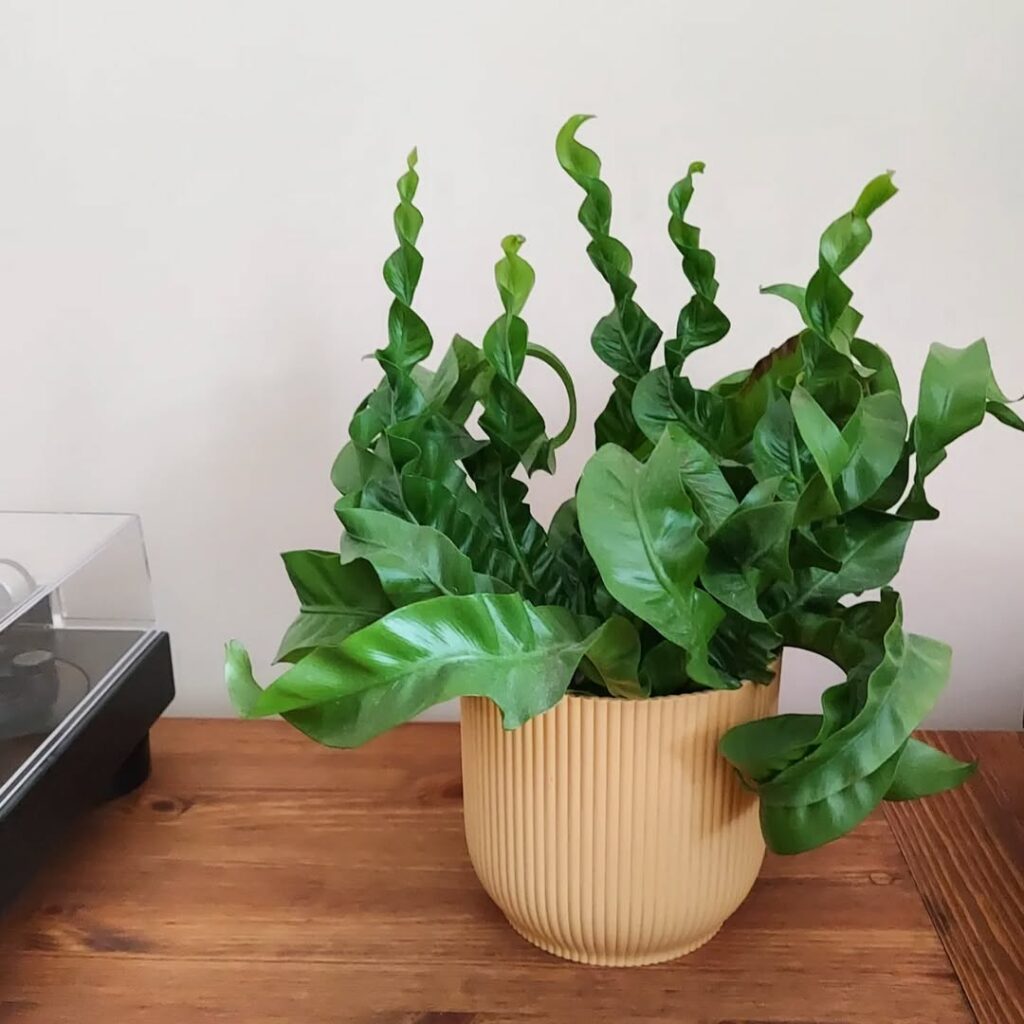
The Bird’s Nest Fern (Asplenium nidus) is a striking tropical plant characterized by its large, wavy fronds that emerge from a central rosette, resembling a bird’s nest. These distinctive fronds can grow up to 2-4 feet long and have a bright green, glossy appearance with a prominent black midrib running down their centers. Unlike typical ferns with delicate, lacy foliage, the Bird’s Nest Fern features simple, undivided fronds that add a bold architectural element to indoor spaces.
- Light: Bright indirect light; avoid direct sunlight which can scorch leaves
- Water: Keep soil consistently moist but not waterlogged; water when top inch of soil feels dry
- Humidity: High humidity (60-80%); benefits from regular misting or humidifier
- Temperature: 70-80°F (21-27°C); minimum 55°F (13°C)
- Soil: Well-draining, organic potting mix rich in humus
- Fertilizer: Feed monthly during growing season with balanced liquid fertilizer diluted to half strength
- Container: Pot with drainage holes; prefers to be slightly rootbound
- Special needs: Avoid getting water in center crown to prevent rot
10. Striking Spider Plant
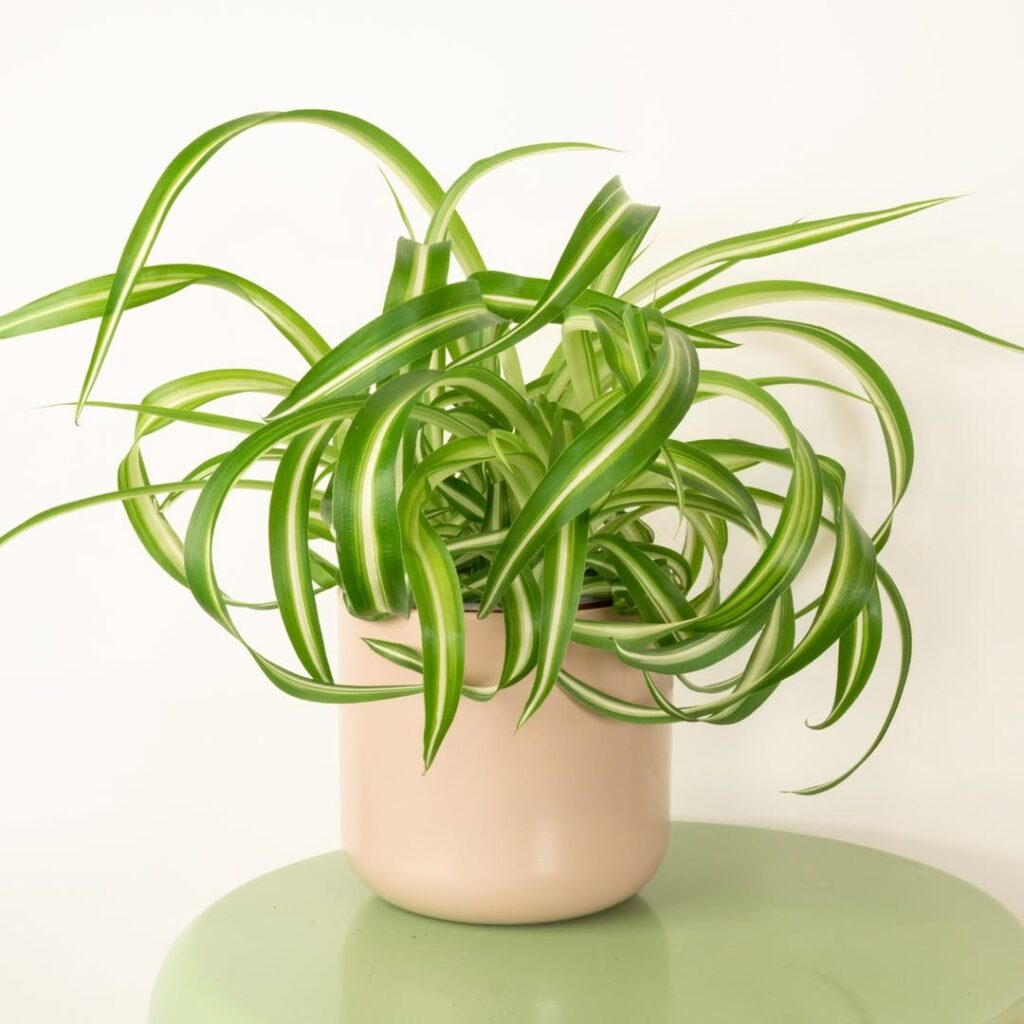
Spider plants (Chlorophytum comosum) are beloved for their graceful, arching stems adorned with cascading plantlets that give them a dramatic, fountain-like appearance. Their long, slender leaves feature cream or white stripes running lengthwise, creating an eye-catching variegated pattern. These hardy plants earned their common name from the spiderette offspring that dangle from thin stems, resembling spiders suspended on delicate webs.
- Light: Bright, indirect light; can tolerate lower light but may lose variegation
- Water: Keep soil consistently moist but not waterlogged; allow top inch to dry between waterings
- Humidity: Thrives in humid conditions; 50-60% humidity ideal
- Temperature: 60-75°F (15-24°C)
- Soil: Well-draining potting mix rich in organic matter
- Fertilizer: Feed monthly during growing season with balanced liquid fertilizer
- Container: Choose pot with drainage holes; can become rootbound without issue
- pH: 6.0-7.2
11. Dainty Purple Waffle Plant

The Purple Waffle Plant (Hemigraphis alternata) is a striking tropical plant known for its distinctive crinkled leaves with deep purple undersides and silvery-green tops, creating an eye-catching contrast. This low-growing, spreading plant gets its common name from the unique textured appearance of its foliage, which resembles a waffle’s surface. Native to tropical regions in Asia, it thrives in humid environments and makes an excellent houseplant, growing to about 6 inches tall with a spreading habit that works well in hanging baskets or as ground cover.
- Light: Bright, indirect light; can tolerate medium light but avoid direct sun
- Water: Keep soil consistently moist but not waterlogged; water when top inch of soil feels dry
- Humidity: High humidity (60-80%); benefits from regular misting or humidifier
- Temperature: 65-80°F (18-27°C)
- Soil: Well-draining, rich potting mix with organic matter
- Fertilizer: Feed monthly during growing season with balanced, water-soluble fertilizer
- Growth Pattern: Trailing/spreading habit; trim regularly to maintain shape
12. Cascading English Ivy
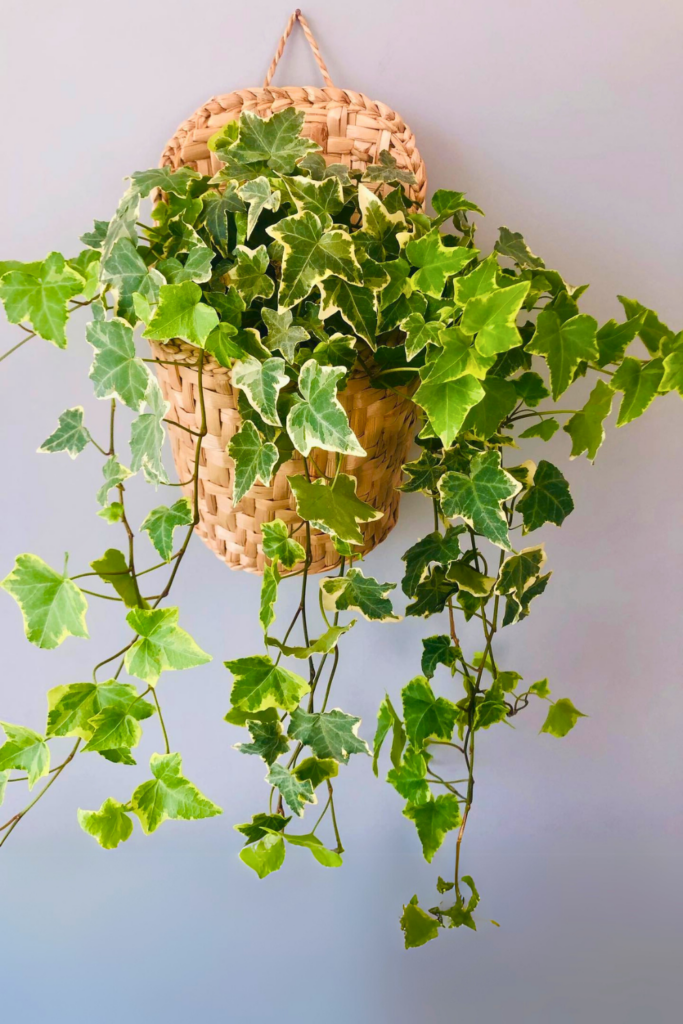
English Ivy (Hedera helix) is a versatile trailing plant that thrives in humid environments, making it perfect for bathrooms and indoor spaces with higher moisture levels. Its cascading vines feature distinctive lobed leaves in various shades of green, sometimes variegated with white or yellow patterns. This classic climbing plant can grow several feet long, gracefully spilling over hanging baskets or climbing up trellises and walls with its aerial roots.
- Light: Bright to moderate indirect light; avoid direct sunlight
- Water: Keep soil consistently moist but not waterlogged; mist leaves regularly
- Humidity: High humidity levels (60-80%)
- Soil: Well-draining potting mix rich in organic matter
- Temperature: 60-75°F (15-24°C)
- Fertilizer: Feed monthly during growing season with balanced liquid fertilizer
- Pruning: Regular trimming to control growth and maintain shape
- Container: Use containers with drainage holes; hanging baskets or elevated pots ideal for cascading growth
Here’s a refined entry for Rex Begonias, replacing the Cuban Oregano section in your blog:
13. Rex Begonia
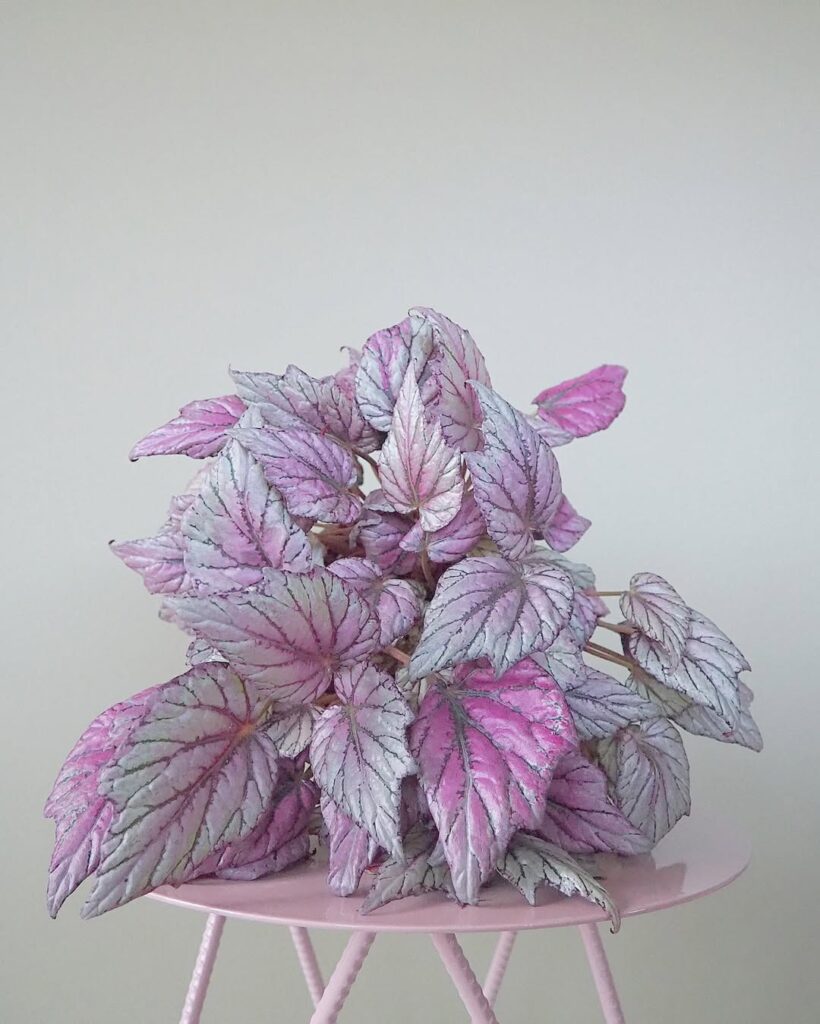
Rex Begonias are prized for their stunning foliage, featuring intricate patterns in shades of silver, pink, purple, and green. Their asymmetrical leaves and metallic sheen add a dramatic touch to indoor spaces, making them a favorite among houseplant enthusiasts. These tropical beauties thrive in humid environments, flourishing in warm temperatures with consistent moisture. Though they can be finicky, their striking appearance makes the extra care worthwhile.
- Light: Bright, indirect light; avoid direct sun to prevent leaf scorching
- Water: Keep soil lightly moist, but avoid overwatering; water when the top inch feels dry
- Humidity: High humidity (50-80%); ideal for terrariums or rooms with a humidifier
- Temperature: 65-75°F (18-24°C)
- Soil: Well-draining, peat-based potting mix with good aeration
- Fertilizer: Feed every two to four weeks with a diluted balanced liquid fertilizer during the growing season
- Container: Pot with drainage holes; prefers shallow containers
- Propagation: Easily propagated through leaf cuttings placed in moist soil or water
14. Sturdy Rubber Fig Plant
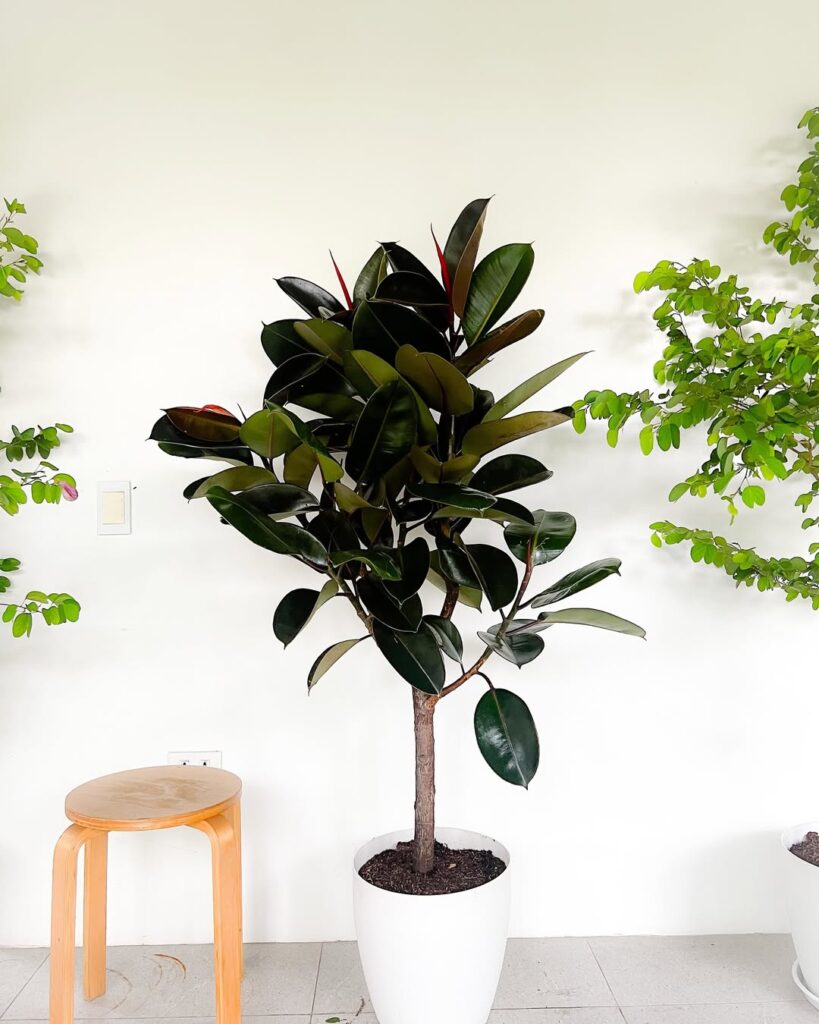
The Rubber Fig Plant (Ficus elastica) is a striking tropical houseplant known for its large, glossy leaves and robust nature. Native to Southeast Asia, this plant can grow quite tall indoors, reaching heights of 6-10 feet when properly maintained. Its thick, leathery leaves are typically dark green with a beautiful sheen, though some varieties feature variegated patterns or burgundy coloring. The plant’s sturdy stems and ability to tolerate various indoor conditions make it a popular choice for both novice and experienced plant enthusiasts.
- Light: Bright, indirect light; can tolerate moderate light but may grow slower; protect from direct afternoon sun
- Water: Allow top 1-2 inches of soil to dry between waterings; reduce watering in winter
- Humidity: Thrives in humid environments (50-60%); benefits from regular misting
- Soil: Well-draining potting mix rich in organic matter
- Temperature: 60-85°F (15-29°C); avoid cold drafts
- Fertilizer: Feed monthly during growing season with balanced liquid fertilizer
- Container: Large pot with drainage holes; repot every 2-3 years
- Growth Pattern: Moderate to fast growth rate; may need pruning to control size
15. Showy Dragon Plant

The Showy Dragon Plant (Dracaena marginata) is a striking tropical houseplant known for its slender stems topped with long, narrow leaves. This architectural plant can grow up to 6 feet tall indoors and features multiple stalks of varying heights, creating a dramatic layered effect. The sword-like foliage forms rosettes at the stem tips, and as the plant matures, lower leaves naturally drop to reveal an attractive bamboo-like trunk.
- Light: Bright indirect light; can tolerate medium light but avoid direct sun
- Water: Keep soil consistently moist but not waterlogged; reduce watering in winter
- Humidity: Thrives in high humidity; mist regularly or use a humidity tray
- Temperature: 65-80°F (18-27°C)
- Soil: Well-draining potting mix rich in organic matter
- Fertilizer: Feed monthly during growing season with balanced liquid fertilizer
- Container: Choose pot with drainage holes to prevent root rot
- Growth Rate: Moderate to slow
